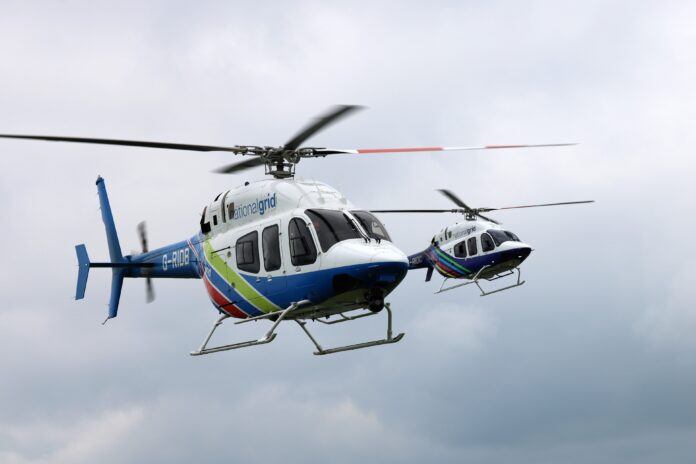- You might see a National Grid helicopter flying next to a pylon near you
- The aircraft help to monitor electricity networks quickly, safely and cost-effectively
- Helicopter teams are part of a 4,000-strong field staff keeping the networks in prime condition
National Grid’s fleet of high-tech helicopters is patrolling pylons and power lines across the country – a high wire act they have been performing for over six decades to keep the electricity network in good health all year round.
Hovering near the high voltage cables that carry power around Britain is all in a day’s work for the helicopter teams, who are closely monitoring the condition of the thousands of towers, poles and overhead lines that get electricity to where it’s needed.
With so much critical infrastructure being monitored each year, the aircraft collectively cover around 32,000 miles of network annually on their patrols. It’s a job the helicopter units have been doing since the 1960s when the South Western Electricity Board (SWEB) first took to the air.
Today the company operates eight helicopters across its networks – three to monitor the 22,000 pylons, 300 substations and 4,500 miles of high voltage overhead line that make up the transmission network in England and Wales; and five to cover the 60,000 miles of lower voltage overhead line on its distribution network that connects to homes and businesses.
Find out more about the difference between National Grid’s networks
You can’t miss them – the distribution network helicopters operating in the Midlands, South West and South Wales are bright yellow, and the transmission network helicopters covering all of England and Wales are in National Grid’s white and blue livery.
Last year TV personality Guy Martin joined the transmission network helicopter team for some power line surveillance, helping to monitor the condition of some electricity infrastructure in Nottinghamshire as part of the Channel 4 show Guy Martin’s Great British Power Trip.
What are the helicopters looking for?
A skilled team in each helicopter is looking for damaged parts, wear and corrosion on the pylons and cables – but they’re also looking for other potential issues in the area like vegetation growing too close to a line.
They have even helped rescue livestock they have spotted stuck in bogs and ditches, by calling it in to local landowners.
An experienced pilot keeps the helicopter’s movements steady while specialist observers gather the imagery needed by network engineers – so you might see one of the aircraft flying close to an electricity line briefly before moving on.
The teams also have state-of-the-art electro-optics such as thermal imaging cameras at their fingertips to help identify issues like ‘hot spots’ on overhead lines – a rare occurrence but an indication of an overheating joint that will need fixing to avoid future faults.
Why are the helicopter checks important?
Aerial surveys are safer, more cost-effective and less resource-intensive than climbing the entire network of pylons or inspecting the wood poles by foot. It might take three lineworkers on the ground several days to carry out inspections on a handful of towers that would take an airborne observer just hours to inspect.
Crucially the helicopter teams’ work can spot potential issues before they go wrong, feeding back insight for National Grid’s overhead line maintenance teams to take action on if needed.
It is estimated that for the cost of running the transmission network’s helicopters, there’s a tenfold cost saving in refurbishment and fault prevention on the high voltage grid.
What if a helicopter can’t be used?
In some cases pylons and lines can’t be inspected closely by helicopter, for example those in heavily built up areas or where there are significant numbers of people or livestock.
National Grid has a fleet of drones in its arsenal – and a team of skilled operators – for use in these situations. The drones are equipped with similar technologies to the helicopters to help identify issues on the network; the company is even trialling autonomous drones.
While drones have benefits in terms of cost and efficiency, helicopters have their own advantages – they can cover longer distances, and they don’t require access to the land close to powerlines.
The teams behind the helicopter operation
Across both National Grid’s transmission and distribution networks, the helicopter teams are operated by 25 full-time staff, including eight pilots and eight observers.
The transmission network unit is based in Oxford, while the distribution network operation is based in Bristol and has an in-house maintenance engineering team.
John Rigby is chief pilot at National Grid covering the transmission network, bringing to the role 32 years’ flight experience with the Royal Air Force, Air Ambulance and National Grid. He said:
“Our priority is to check the condition of the network’s overhead lines and substations to confirm they are shipshape all year round.
“That means flying closer to the electricity infrastructure than general aviation are allowed, which concentrates the mind – but it’s a very safe and controlled operation, one that our experienced teams have been carrying out for decades.
“Predicting where we will be on any given day is difficult as we can be quite weather dependent. We’re a small, flexible and nomadic team, staying overnight where the weather and work takes us rather than going back and forth from our Oxford base.”
Simon Richards, helicopter observer team manager for National Grid’s distribution network, said:
“As an observer on the distribution network it’s our role to navigate the pilot and aircraft to inspect the overhead network of wood poles and towers across the Midlands, South West and South Wales.
“Our yellow aircraft are normally spread across that area, so can reach anywhere on the National Grid distribution network within 30 minutes.
“Spotting issues from the air is easier said than done – at normal patrol speeds we will pass a pole every 10 or so seconds, so it can be quite intense and at times challenging. But we have technology to help us, including thermal cameras and a LiDAR system.”
Both the helicopter operations and regular nationwide ground-based patrols by overhead line teams are crucial in making sure electricity networks remain in prime condition.
The teams are part of a multibillion pound annual investment by National Grid in maintaining and upgrading its infrastructure to ensure a resilient network for homes and businesses in England and Wales.
Overall a 4,000-strong operational field staff works 365 days a year across National Grid’s transmission and distribution networks to keep the grid safe and reliable.

| [donate]
| Help keep news FREE for our readersSupporting your local community newspaper/online news outlet is crucial now more than ever. If you believe in independent journalism,then consider making a valuable contribution by making a one-time or monthly donation. We operate in rural areas where providing unbiased news can be challenging. |




















